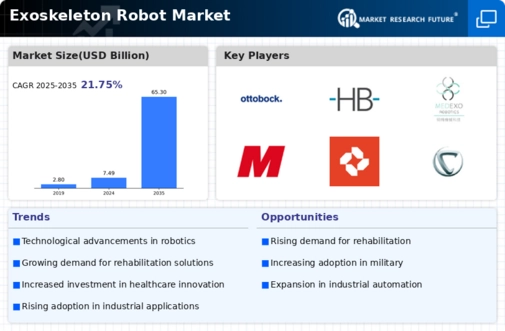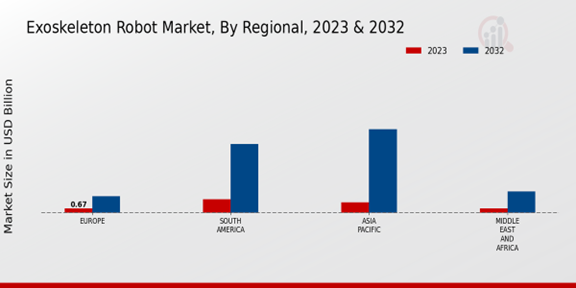Market Growth Projections
The Global Exoskeleton Robot Market Industry is projected to experience substantial growth, with estimates indicating a market value of 7.49 USD Billion in 2024 and a remarkable increase to 65.3 USD Billion by 2035. This growth trajectory suggests a compound annual growth rate of 21.75% from 2025 to 2035, reflecting the increasing adoption of exoskeleton technology across various sectors. As advancements in robotics continue to evolve, the market is poised for significant expansion, driven by factors such as technological innovation, rising demand for rehabilitation solutions, and enhanced workplace safety measures.
Growing Awareness of Workplace Safety
The Global Exoskeleton Robot Market Industry is increasingly influenced by the growing awareness of workplace safety. Industries such as construction and manufacturing are adopting exoskeletons to reduce the risk of musculoskeletal injuries among workers. These devices assist employees in lifting heavy objects and performing repetitive tasks, thereby enhancing productivity while minimizing injury rates. As organizations prioritize employee well-being, the integration of exoskeletons into workplace safety programs becomes more prevalent. This trend not only improves worker safety but also contributes to the overall efficiency of operations, further driving market growth.
Technological Advancements in Robotics
Technological advancements play a pivotal role in driving the Global Exoskeleton Robot Market Industry. Innovations in materials, sensors, and artificial intelligence enhance the functionality and usability of exoskeletons. For instance, lightweight materials improve user comfort, while sophisticated sensors enable real-time feedback and adaptability to various environments. These advancements not only increase the efficiency of exoskeletons but also expand their applications across diverse sectors, including military and industrial settings. As a result, the market is expected to grow significantly, with a projected value of 65.3 USD Billion by 2035, reflecting the potential of these technologies to revolutionize human mobility.
Rising Demand for Rehabilitation Solutions
The Global Exoskeleton Robot Market Industry experiences a notable surge in demand for rehabilitation solutions, particularly in the healthcare sector. As the global population ages, the prevalence of mobility impairments increases, necessitating innovative rehabilitation technologies. Exoskeleton robots provide enhanced mobility and support for individuals recovering from strokes or spinal cord injuries. This trend is underscored by the projected market value of 7.49 USD Billion in 2024, indicating a robust growth trajectory. Healthcare providers are increasingly adopting these technologies to improve patient outcomes, suggesting a shift towards more advanced rehabilitation methodologies.
Expanding Applications Across Various Sectors
The Global Exoskeleton Robot Market Industry is characterized by expanding applications across various sectors, including healthcare, military, and industrial. In healthcare, exoskeletons assist in rehabilitation, while in military settings, they enhance soldier performance and endurance. Industrial applications focus on reducing worker fatigue and injury during physically demanding tasks. This diversification of applications broadens the market's appeal and fosters innovation, as companies seek to tailor exoskeletons to specific industry needs. The increasing versatility of these devices is likely to attract new investments and partnerships, further propelling market growth.
Increased Investment in Research and Development
Investment in research and development is a critical driver of the Global Exoskeleton Robot Market Industry. Governments and private entities are allocating substantial resources to explore new applications and improve existing technologies. This focus on innovation fosters collaboration between academia and industry, leading to breakthroughs in exoskeleton design and functionality. For example, initiatives funded by government grants aim to enhance the performance of exoskeletons in various environments, from healthcare to industrial applications. Such investments are likely to contribute to a compound annual growth rate of 21.75% from 2025 to 2035, indicating a thriving ecosystem for exoskeleton technology.






















